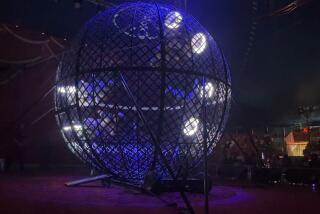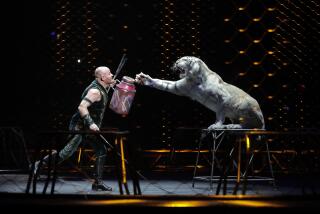Small town, big-top dreams
Cathy DAY performs a balancing act as deft as any tightrope walker’s in “The Circus in Winter,” a marvelous debut collection of connected stories about circus folk and their descendants in a small Midwestern town. Disaster and tragedy abound as individual tales shift in time amid an overarching narrative that spans the end of the 19th century to the dawn of the 21st. Yet there’s magic in the air even after the Great Porter Circus shuts down in 1939 and the children of elephant trainers, clowns and roustabouts, who had merely wintered in Lima, Ind. (fictional stand-in for the author’s hometown, Peru, Ind.), settle to work in trailer camps, banks and funeral parlors.
It’s the magic of people longing for the extraordinary, as embodied in the circus, even though the book reveals that its promises of freedom and glamour are largely illusory. The son of a slave quits his miserable job cleaning white people’s chamber pots only to end up humiliating himself for their amusement as “Boela Man, the African Pinhead.” His son, who sees a brutal trainer deliberately drowned by one of the abused elephants, later shows his daughter a newspaper article depicting the animal as a murdering beast and says, “The truth ain’t nothing but a lie that folks learn to live with.”
The inhabitants also experience the deadly gap between fantasy and reality: A boy shoots his twin brother to death while playing cowboys and Indians in a barn filled with circus relics, including a stagecoach emblazoned with the words “TONY COLORADO’S LONE STAR COWBOY SHOW.” “The accident had been all her fault,” the narrator says of their mother, who has been dreaming about sexy Tony Colorado. “She couldn’t tell real from imagined any more than the boys could.”
Dreams are the principal refuge of the dissatisfied in Lima, a dead-end small town like countless others. Laura Hofstadter, daughter of a man who gave up clowning for a dry cleaning business and a loveless marriage, doesn’t want to marry the rich boy who gets her pregnant; during the ceremony, she envisions for herself a different story “full of color and Chicago skyline ... a silver cigarette case and red lipstick on a cocktail napkin.” Fifteen years later, she vanishes after telling her daughter Jenny that there are two kinds of people in the world: “The kind who stay are town people, and the kind who leave are circus people.”
Day has already shown us that circus and town people are not as different from each other as Laura thinks, and she draws her thematic threads together with impressive skill and lyrical warmth in the final chapter, which finds Jenny returning to Lima for Grandpa Ollie’s funeral. Like her mother, Jenny “needed a horizon that wasn’t horizontal”; she fled the Midwest for graduate school and the peripatetic life of an academic. She and her friends are footloose, modern-day circus people. “[L]ate into the night, we tell stories about how we got here -- the towns we left.”
In the end, a clown’s granddaughter is much like any other restless American who happily leaves home only to discover years later that “this nowhere place keeps talking to me anyway.” Redolent of sawdust and tinsel and rich in the particulars of circus history, this lovely book reminds us that the conflict between the desire for freedom and the need for security, between wanting to invent a new identity and knowing who you are, takes place in every human heart. *
More to Read
Sign up for our Book Club newsletter
Get the latest news, events and more from the Los Angeles Times Book Club, and help us get L.A. reading and talking.
You may occasionally receive promotional content from the Los Angeles Times.







